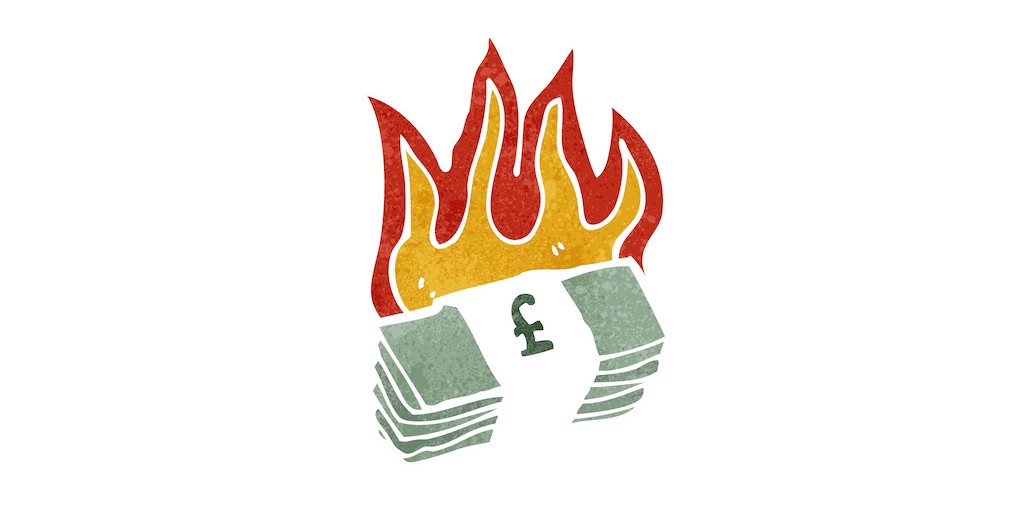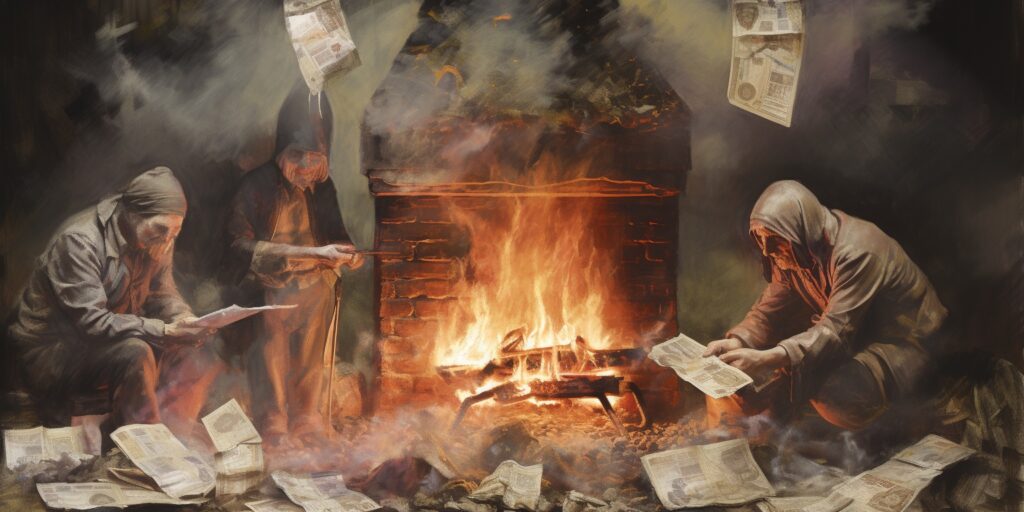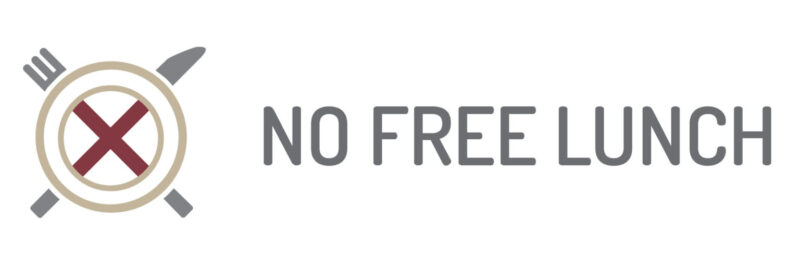
Learn why Central Banks incinerate money, why the KLF burned £1 million on a remote Scottish island for art & why crypto protocols are designed to burn coins.
Given how much of life is centred on the pursuit of money, it may come as a surprise to learn that sometimes money is intentionally destroyed. Understanding the motives for burning money in both a literal and figurative sense might change your perception of what money really is and who controls it.
Burning Money – Central Bank Incineration
By far, the biggest monetary vandals are the same institution that issues money in the first place – Central Banks. The Bank of England, for example, operates incinerators to regularly burn vast quantities of banknotes. Here’s why:
Withdrawing money from circulation
The BoE periodically updates banknotes, improving their security and changing their design. The death of Queen Elizabeth, for example, could eventually see huge stocks of money withdrawn and replaced.
The BoE website lists notes that are no longer legal tender, which can be exchanged at a High Street branch or the BoE by post.
Recovering damaged money
In 1988, the Reserve Bank of Australia was the first to print polymer notes for their improved durability. Polymer is now the standard for modern notes, but wear and tear still takes its toll. Most central banks will exchange notes so long as 50% remains, but stupidity can be far more damaging.
In 2020, a Seoul resident placed an unspecified amount of 50,000-Won banknotes in a washing machine, concerned about COVID-19 contamination. The Korean Central Bank exchanged only a portion of the notes, returning £16,700 worth of new notes. Where money laundering is concerned, this was an epic fail. Reference
Recovering tainted money
Organisations holding large amounts of cash are encouraged to use storage boxes with in-built dye staining devices. Banknotes tainted by dye are unusable, so they are exchanged for new notes.
Incinerators – Where money goes to die
So the burning question is – what happens to all these banknotes that are damaged, withdrawn or laundered to pulp? The simple answer is that banks incinerate redundant money.
Knowing that banknotes beyond their useful life get torched should tell us two things:
- Money is just a tool that sometimes needs replacing.
- Banknotes have no intrinsic value & almost infinite amounts can be printed.
Given our attachment to money, the idea of burning it generates a visceral reaction, like seeing good food thrown away. That emotion may have inspired four employees at the Bank of England’s incinerator plant In Loughton, Essex, who, between 1988 and 1992, stole over £600,000 of used bank notes due for incineration. Reference.
As painful as the idea of incinerating banknotes is to bear, there is clearly a need to replace unusable notes with new versions, but it’s much harder to understand burning a £ 1 million just for shits and giggles.
Burning money for art – The K Foundation Burn a Million Quid
Art often questions our obsession with money and the uses to which it is put. British artist Michael Landy publicly destroyed all of his possessions, including artworks, personal items, and even money. as part of his performance art piece titled “Break Down” in 2001.
And in 2004, “Di-Faced Tenner,” by anonymous street artist Banksy, featured an image of Princess Diana on a British £10 note that he distributed for free, encouraging recipients to burn the notes as a commentary on the exploitation of her image.
But neither of those examples of momentary vandalism can hold a candle to the K Foundation Burn a Million Quid. A story so bizarre that many people dismissed it as an urban myth, especially because the duo who orchestrated the banknote bonfire struggled to articulate why they did it.
The K Foundation was a performance art spin-off from the highly successful electronic pop careers of Bill Drummond and Jimmy Cauty, who, in the early 1990s, performed under various names, The Timelords, Justified Ancients of Mu Mu, and most notably, the KLF.
The KLF were notorious for being anti-pop and completely unpredictable. At the 1992 Brit Awards, where they won the Best Group award, they announced their immediate retirement and left a dead sheep at the after-party entrance with the note ‘I died for ewe. Bon appetit.’
The sheep stunt was actually a compromise from Drummond’s original idea to severe his hand live on stage. By comparison, the money stunt seems tame.
Drummond tells me with absolute conviction that his first wish for the 1992 Brit Awards was to cut off his hand and throw it into the audience.
Andrew Smith, Observer interview with Bill Drummond, February 13th, 2000
After numerous hits, Drummond and Cauty dramatically ended their music careers in May 1992 and, despite the significant financial cost, deleted their entire back catalogue, a sign of what was to come.
Calculating that after tax, their music careers had generated roughly £1 million in profit, the duo decided to make art with the money. The initial plan, in late 1993, was to nail the money to a pine frame and take the installation on a tour of art galleries, but there was limited appetite for the stunt name Money: A Major Body of Cash. Not to be discouraged, Drummond and Cauty doubled down with a more dramatic gesture. Burn it all.
How the KLF burned £1 million
So, on August 23rd 1994, in a disused boathouse on the Hebridean island of Jura, the KLF Foundation set about burning £ 1 million in 20 bundles, each containing £50k, in the presence of Observer journalist Jim Reid and collaborator Gimpo, who filmed it.
Ironically, the plan proved harder than expected to execute, with only £900,000 burned and roughly 10% escaping up the chimney, in a reverse Santa metaphor, some of which was later found by locals; £1,500 of which was handed in by a local fisherman to Islay police.
According to Reid, the film and photographic evidence were destroyed two days later, though it subsequently transpired that Gimpo had retained copies.

Cauty later told a BBC documentary, ‘Every day I wake up, and I think ‘Oh God, I’ve burnt a million quid and everyone thinks it’s wrong’.
Whether you feel the K Foundation were geniuses or madmen may depend on your financial status. Fundamentally, money represents our labour, the effort we put into survival and creation, so burning a whole chunk of it, for many, might feel like a sick joke. But if you’re in the mood to be shocked, wait until you hear how much digital money gets burned every day.
Burning Crypto
First things first. Using the term ‘burn’ in relation to crypto is metaphorical, but unlike much of the dense and unintelligible jargon describing aspects of crypto, the concept of burning digital coins is fairly intuitive.
You now know how and why Central Banks burn money, the main reason being to withdraw it from circulation. They do that for two reasons: firstly, because more money can drive up inflation and secondly, because of the need to improve durability, security and design.
Clearly, the second issue isn’t relevant to something that only exists virtually, so we can concentrate on how cryptocurrencies burn coins to reduce their supply and manage their inflation.
Ethereum, the second most important crypto by market cap (value x number of coins), recently updated its rules to burn a portion of the fees paid by digital applications to rent decentralised processing power. This resulted in Ethereum switching from inflationary (constantly growing supply) to deflationary (shrinking supply).
HAY Token & the $650bn bonfire
Now, if you think that the KLF were cuckoo burning £ 1 million in cash, that is chicken feed compared to the $650bn of value Hayden Adams burned in October 2023.
Adams is the founder of a decentralised exchange for trading crypto called Uniswap. In 2018, he created the HAY Token as an experiment, releasing around 0.01% into the wild and keeping 99.99% in his own wallet.
But crypto being crypto, traders started speculating on the tiny circulating supply. Rather than cash in, Hayden made the honourable, if somewhat bizarre, decision to burn his stash, which represented roughly $650bn of theoretical value.
I’m uncomfortable owning almost the entire supply (~99.99%) of a token that people are memeing and speculating on, so I decided to burn the full amount in my wallet (”valued” at an absurd ~$650b).
Hayden Adams on X (formerly Twitter)
Fiat’s big secret
Now, you might think it’s nuts that cryptocurrencies can burn or generate coins by just changing a few lines of code. It is no surprise that many abused this privilege and provided no meaningful value.
But whisper this quietly: traditional money works in precisely the same way; nothing backs your banknotes than trust in Central Banks not to abuse their power to create money at will. The official term for the destruction of money is currency debasement.
This is why banks burning money is relevant simply because it underlines that banknotes are just valueless bits of paper that Central Banks can print at will or, more commonly, create with a few keystrokes on their centralised database.
On August 23rd 1994, in a disused boathouse on the Hebridean island of Jura, the KLF Foundation burned £ 1 million in 20 bundles, each containing £50k, in the presence of Observer journalist Jim Reid and collaborator Gimpo, who filmed it.
Yes, it is common practice for central banks to incinerate money that is damaged or no longer legal tender.
No Free Lunch
There is no such thing as a free lunch, but if you’re hungry to find out why, we’re here to help.
You can learn the meaning and origin of the no free lunch concept, as well as the broader philosophy behind the idea that nothing can ever be regarded as free.
We look at our relationship with money and truth, examining all of the supposed shortcuts, life hacks and get-rich-quick schemes.
